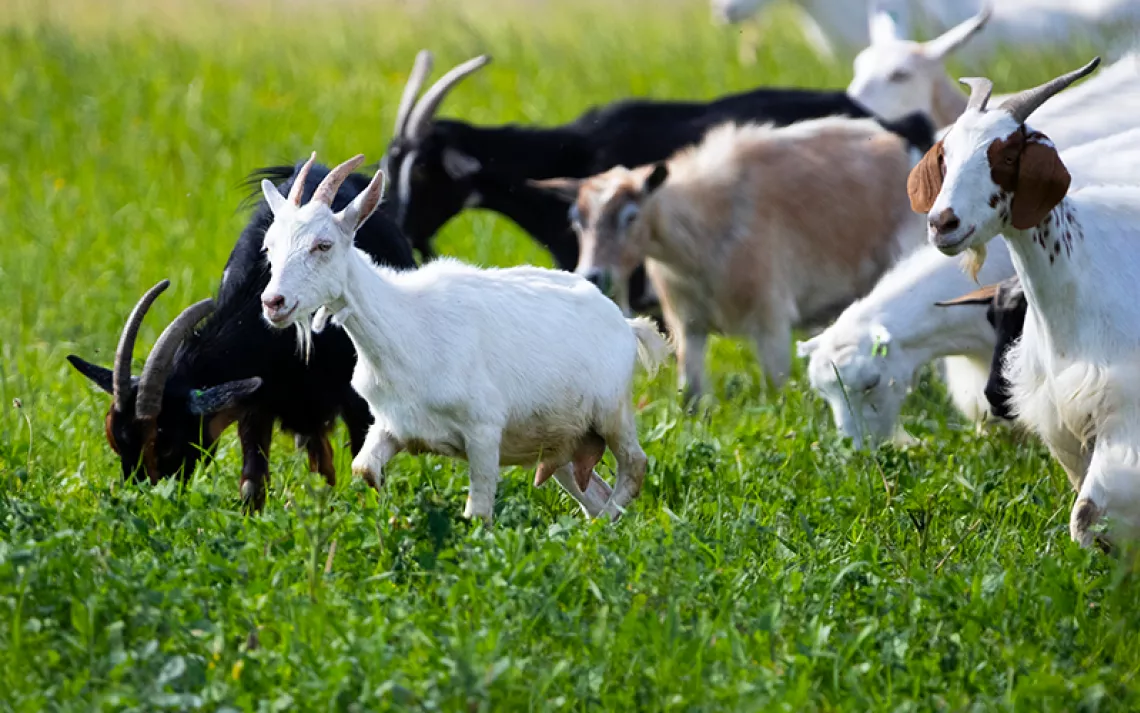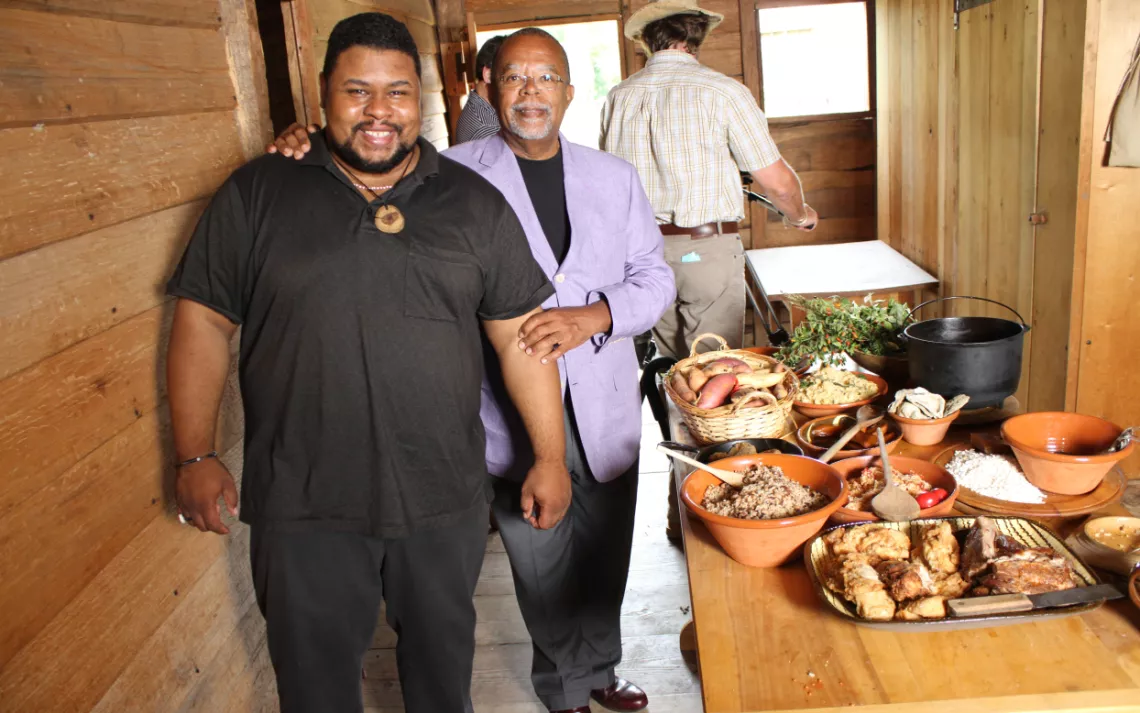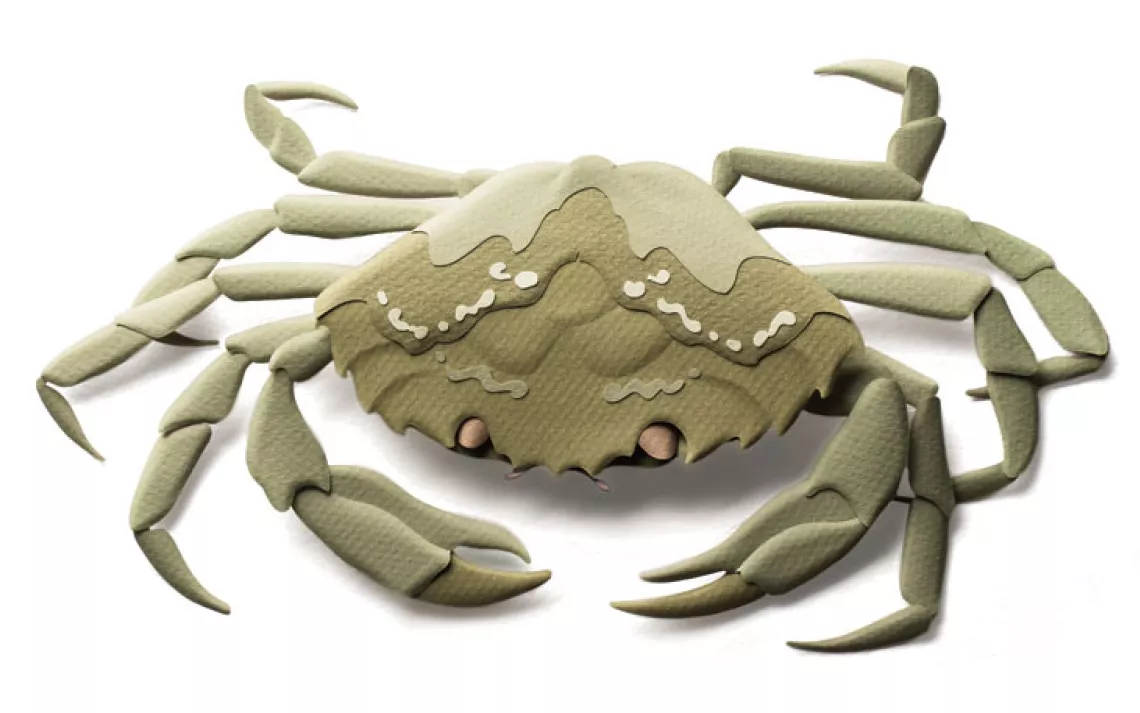Eat Your Bugs!
There are many environmental reasons to eat insects. But first you have to get past the ick factor.

Photo illustration by Aaron Goodman
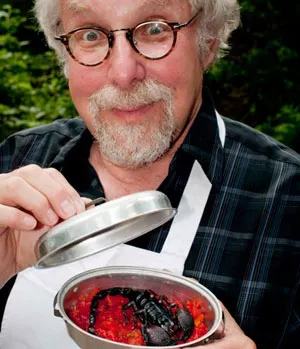
You have to be careful not to overcook scorpions. The exoskeleton traps steam, and they're messy when they pop.
"But get it right," said "Bug Chef" David George Gordon to the swarm of curious faces gathered to watch him work, "and they taste like soft-shell crab."
It was Halloween night. I'd trekked across Portland, Oregon, for a bug-cooking demonstration at Paxton Gate, a store that owner Andy Brown describes as "a natural history museum where everything is for sale." Feats of unusual taxidermy covered the walls. There were piranhas, peacocks, and baby lambs mid-frolic. Owl pellets filled a glass jar in one display; another held mouse skeletons sitting upright in tiny royal costumes. It was nightmarish and wonderful, rewarding for the curious but troublesome for the squeamish. Much like what we were about to do.
Bearded and jovial, Gordon calls himself a chef even though he's not associated with any restaurant. He began collecting insect-based recipes in 1996 and two years later published The Eat-a-Bug Cookbook, which includes tonight's two demonstration recipes: tempura-battered mealworms and scorpion scaloppine. Both were made with limited seasoning, Gordon said, because he didn't want to overpower the taste of the insects. Dessert, however, was chapulines (fried grasshoppers) dipped in chocolate. They tasted like chocolate.
I wanted to enjoy eating bugs, I truly did. I've eaten pig ears, sheep intestines, and cow brains, but always in other countries, among other cultures. Here in Portland, however, my stomach turned when I found a side table topped with cups of cricket-laden Chex Mix, and I hesitated before popping one into my mouth. As I crunched it in my back molars, the crispy layer of chitin burst open, exposing a soft but not quite gooey interior. It was like a peanut butter-filled pretzel with legs. The taste was subtle and vaguely citrusy, but I didn't allow myself to dwell on it. Instead, I swallowed hard, as if taking a pill, and focused on denying the grasshopper round-trip privileges.
Others in the costumed crowd seemed to be having similar struggles. "I can't do this. I just can't do this. Aaargh," exclaimed a teenager dressed as Wonder Woman.
"That tastes . . . different," said a grimacing cowgirl chewing on a scorpion.
But not everyone was put off. "They have such a neutral flavor profile that it's tough to figure out what to do with them," said Jason Fritz, a local chef nibbling studiously off to the side. "Maybe some sort of confit. It almost makes me want to source some of this stuff and play around with it."
At the front of the room, Gordon was playing around with a group of kids.
"Some people not only eat chicken," he said, showing them a rubber chicken, "but also the stuff that comes out of its butt."
Their eyes widened.
"Eggs!" he yelled.
He's been doing this for 15 years.
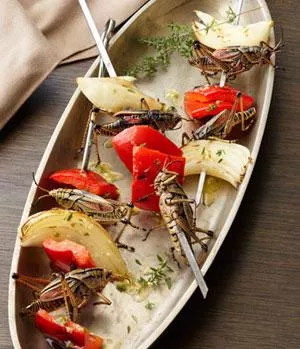
"I use cooking demonstrations to get people to think about their food," Gordon later told me. Only over the past five years, he said, have people started taking seriously the idea that bugs can be an everyday source of protein.
Nothing overcomes the bug/barf barrier like the combination of hunger and ready availability.
To illustrate, Gordon pulled up some pictures on his phone. The cover of his 1998 cookbook, released when eating bugs was a true novelty, is wacky: Gordon scooping up a tarantula with a spatula. But the cover of the reissue that's coming out this July features a skewered grasshopper elegantly placed atop a bowl of chocolate against an all-white background. "You can see how it's transforming," Gordon said. As an ingredient, insects are starting to get some respect.
In many other parts of the world, of course, entomophagy—the technical term for eating insects—is old hat. It's largely North Americans and Europeans who continue to link insect ingestion to barfing. But at the culinary vanguard, insects are undergoing an evolution from gross to exotic to commonplace. Copenhagen's Noma, which has been recognized as the world's best restaurant three years in a row by Restaurant magazine, announced last year that it's undertaking a formal study of bugs in order to "create a gastronomic argument that will make insects an acceptable food in the Western world."
Although Noma's intellectual efforts probably won't make bugs more appetizing to the everyday shopper anytime soon, something else is pushing insects onto some plates. Call it the ecological imperative. As protein sources go, bugs may be more sustainable than almost anything else in our diets. Since they don't waste energy generating their own heat, they can be (depending on the species) four times more efficient than mammals at turning feed into protein. Insects also seem to account for fewer greenhouse gases than the livestock we traditionally consider delicious. One life cycle assessment of mealworms showed that they produce 29 percent less carbon dioxide equivalent per kilogram of protein than chickens, 32 percent less than pigs, and 81 percent less than cattle.
Still, even those who find such statistics compelling don't appear to be rushing to make mealworms a regular part of their diet. Carbon-output charts rarely sway appetites. Until someone can convince us to eat insects by choice rather than out of gourmet bravado, ecological arguments might as well be shouted at the bugs themselves.
ENTREPRENEUR PAT CROWLEY accepts that challenge.
When I called him last fall to chat about his new cricket-based energy bar company, Chapul, we ended up discussing Lakeside Cave, a remote archaeological site on the desolate western shore of Utah's Great Salt Lake that once contained a minor ethnobiological mystery. He wanted to visit it, he said. Did I want to join him?
A few weeks later, we set out from Salt Lake City very early in the morning, braced to spend most of the day searching for the cave. We'd come prepared for almost anything—except the ease of our hunt. Not long after breakfast, we stood on the shore looking into Lakeside Cave's dark mouth.
We'd trekked here because in 1984, when archaeologist David Madsen had dug into the cave's sediment floor, he'd found the remnants of 5 million grasshoppers. Puzzled at first, he soon found bits of 'hopper in some dried human feces nearby. The bugs had been for dinner, it seemed, but their sheer number sounded impossible. He assumed that catching grasshoppers was tedious work. How had they gathered so many?
The answer came a year later when some of Madsen's friends who were hiking the shore of the Great Salt Lake came upon huge piles of grasshoppers washed up on the beach, sun-dried and seasoned by the lake's brine. Madsen estimated that there were as many as 10,000 grasshoppers per foot of shoreline, deposited in windrows up to six feet wide and nine inches tall.
Then Madsen calculated the energy expended in gathering the grasshoppers and compared it with the energy they provided. Lakeside Cave dwellers would have been able to gather about 200 pounds of grasshoppers per hour, he wrote in Natural History magazine, with the bugs yielding 1,365 calories per pound. Even if he had somehow overestimated the rate of return by a factor of 10, he figured, the only thing as calorically rewarding as eating grasshoppers would have been finding 43 Big Macs stacked on the sand.
When Madsen removed the lake's uncommon bounty from the equation, he still found that gathering bugs by more traditional methods—like herding them into ditch traps or streams and scooping them out—compared favorably to most forms of hunting.
Though grasshoppers may not have been the most delectable edibles in the West, they were among the easiest food sources to find. And nothing overcomes the bug/barf barrier like the combination of hunger and ready availability.
This trip to Lakeside Cave was a sort of pilgrimage for Crowley, since his business exists to convince people to eat more insects. His Chapul energy bars look and taste like healthy cookies but are mostly made of crickets. He hopes they can do for entomophagy what the avocado-laden California roll did for sushi—make the unfamiliar palatable to everyday Americans.
A WATERSHED HYDROLOGIST BY TRAINING, Crowley was born in Phoenix and has spent most of his life in the Colorado River Basin. He has a beach bum's blond mane and a laid-back comportment left over from a stint as a surfing instructor, but he's also the type to measure trail runs in hours. After graduate school, his work quantifying agricultural water use and helping cities hash out water rights left him feeling increasingly frustrated with the prospects for changing the country's water management systems.
Then, one day in June 2011, he was riding Salt Lake mass transit and listening to a TED Talk by Dutch entomology professor Marcel Dicke. Give a cow 10 pounds of feed and you get 1 pound of cow, Dicke explained. Give crickets 10 pounds of feed and you get 9 pounds of cricket.
Something clicked. Crowley knew that growing alfalfa for cattle was the biggest single use of water from the Colorado River. In fact, agriculture sucks up more than 90 percent of the freshwater consumed by humans worldwide. Beef requires 15.8 gallons of water per gram of protein; pork, 5.8; chicken, 5.2; and soy, 1.6. Crickets require only 0.8. He started crunching the numbers about how much water could be saved if we got even a small portion of our protein from insects—and he started getting very excited.
The crispy layer of chitin burst open, exposing a soft but not quite gooey interior. It was like a peanut butter–filled pretzel with legs.
Over the next year, Crowley studied how to start a company, picking the brain of anyone in the food industry he could take out to lunch. Last July, his Kickstarter campaign raised $16,000. Making cricket bars throughout the fall in a local kitchen and selling them primarily online, he ran out of his stock by Thanksgiving. This February he hired his first employee. By March, Chapul bars were for sale in 50 stores, mostly natural foods grocers, in 11 states.
Each bar costs $3, but the ingredients aren't exactly cheap, Crowley noted. "It's a good thing that I don't have a business background," he said. "Because I don't know if what I'm doing is a bad idea."
But bugs may not always be relegated to specialty grocers. Two years ago in the Netherlands, a chain of Costco-like stores called Sligro began carrying freeze-dried locusts, mealworms, and other whole insects supplied by Dutch company Bugs Originals. The company also makes a prepackaged product called Bugs Nuggets, which are 80 percent chicken and 20 percent mealworms.
If bugs do find their way onto American shelves, Chapul may not be there alone. Bug Muscle, a start-up in Southern California, is pursuing an insect-based protein supplement for bodybuilders, mixed martial artists, and survivalists—folks who don't care what they're eating so long as it gives them the right type of nutrition, founder Dianne Guilfoyle said.
Like Crowley, Guilfoyle had to learn how to launch a company to get Bug Muscle off the ground. Unlike Crowley, she is marketing and refining her product by giving out samples at cage fights and eyeing a contract with the U.S. military.
Bug Muscle's end goal, however, dovetails nicely with Chapul's.
"We're trying to take the yuck factor out of the American mind-set," Guilfoyle said. "I don't want to stay a small company. I want it to go big."
No matter how big entomophagy becomes, though, it won't take up much room.
Recently, Dutch scientists Dennis Oonincx and Imke de Boer of Wageningen University (the same school where Dicke teaches) analyzed the production of mealworms and found that it requires only one-tenth of the land required to raise an equivalent amount of beef.
"We consider the low [land use] of mealworms to be particularly important," they wrote in the journal PLOS ONE. "Expansion of agricultural land is a major source of [greenhouse gas] production."
Like mealworms, crickets are remarkably space-efficient to raise because they prefer dark, teeming environments. A cricket farm is essentially a concentrated animal feeding operation—without the suffering.
At Timberline Live Pet Food in Marion, Illinois, one of the largest cricket farms in the country, pens are stacked vertically 12 feet tall, which makes for 2.4 million square feet of useful production space in a 200,000-square-foot facility. And with property set aside and builders at the ready, owner Todd Goodman said, his ability to expand the operation is virtually infinite.
So far, though, he sells crickets only as pet food. Last year, 10 companies approached him looking to buy them for human food. And Goodman said he's willing, though he hasn't come to terms with anyone yet. But while he stands to profit from increased consumption, he's not exactly cheerleading the concept.
"I've never eaten a cricket, and I'm not gonna," Goodman said. "And I'm certainly not going to encourage you."
Throughout human history, most agricultural innovations have involved dominating the natural environment. We rerouted rivers and harnessed wild animals to feed ourselves, then fertilized the soil with natural and artificial nitrogen. We engineered cornstalks to grow unnaturally close together and crossbred wheat into a more efficient version of itself.
But entomophagy represents an adaptation in our way of thinking. If we make bugs a regular part of our diet, it means we are responding and adjusting to our environment rather than the other way around. And it's happening without panic or famine, just a slightly shy tummy.
Near the end of our day at the Great Salt Lake, as Crowley and I hiked the shoreline, we stopped for lunch on the leeward side of a rocky outcropping. Snacking on pita bread and mangoes, we discussed the superiority of bugs as a food source. Suddenly Crowley lunged forward and plucked a grasshopper from the grass near his feet. We'd just been talking about how insects and humans are biologically different enough that we aren't likely to pass diseases between species, but I still wasn't quite ready for what came next.
"You want to split this?" he said.
I had just eaten, and the grasshopper was still twitching, and there was a bit of green ooze seeping from its abdomen. But the thing about entomophagy is that unlike with most of our food, the more you learn about bugs, the better they start to sound.
I took it from him and considered my options.
"Cheers," I said.
Q&A: ''Bug Chef'' David George Gordon
Bug chef David George Gordonas been working for the past 15 years to transform bugs from a dare to a Top Chefdish.
Recipes from the Eat-a-Bug Cookbook
Eat-a-Bug Cookbook, Revised: 40 Ways to Cook Crickets, Grasshoppers, Ants, Water Bugs, Spiders, Centipedes, and Their Kin will be released this July. Get a sneak peak!
 The Magazine of The Sierra Club
The Magazine of The Sierra Club
